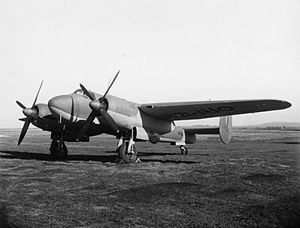Top speed 566 km/h Length 14 m First flight October 27, 1944 | Wingspan 22 m Introduced 1945 | |
 | ||
The Bristol Buckmaster was an advanced British training aircraft operated by the Royal Air Force during the 1950s.
Contents
Design and development
By 1945, there was a serious gap in performance between the so-called advanced trainers in use – such as the Avro Anson, Airspeed Oxford, dual-control Bristol Blenheim and Lockheed Hudson – and the combat aircraft which the pilots would be expected to fly on graduation.
The Bristol response to Air Ministry Specification T.13/43 was to make further use of the Buckingham wing, with another new fuselage, in an aircraft developed as the Type 166. The trainee and instructor were seated side by side with a wireless operator seated behind.
The Buckmaster was a propeller-driven, twin-engine mid-wing aircraft. The retractable undercarriage was of conventional (tailwheel) configuration. The radial engines were equipped with four-blade propellers.
Operational history
A total of 65 Buckingham bombers were unfinished on the production line and ended up being rebuilt as the Buckmaster, to add the production series. All were intended to serve as a trainer for the similar Brigand. It was considered the "highest performance trainer in the RAF" when introduced. Blind flying instruction and instrument training could be undertaken, the normal crew complement being pilot, instructor and air signaller. The last Training Command Buckmasters served with the No. 238 OCU at Colerne into the mid-fifties; the transfer of one or two to Filton for experimental work marked its retirement in the mid-1950s.
Operators
Specifications
Data from Jane's Fighting Aircraft of World War II
General characteristics
Performance
